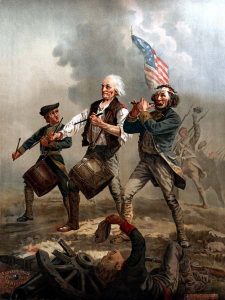 It’s a little bit dangerous to write with disdain about the medical practices of bygone times, as one has to be aware that the passage of time may make some of our contemporary practices look barbaric and primitive in turn.
It’s a little bit dangerous to write with disdain about the medical practices of bygone times, as one has to be aware that the passage of time may make some of our contemporary practices look barbaric and primitive in turn.
For example, our descendents may shake their heads in disbelief at our approaches to cancer, saying to one another, “How could they ever have thought that it was a good idea to poison the patient, in the vague hope that the cancer cells would succumb before healthy tissue? Particularly when it is so easy and obvious that one need only re-regulate cell division and the ‘disease’ vanishes? How primitive and barbaric they were, and how sad that so many patients died as much from the treatment as from the disorder!”
That said, medicine in the Revolutionary era does sound pretty awful to the modern reader. Illness was understood as an imbalance in the four humors, or, if your physician were really keeping up with modern medical thought, in terms of acidity and alkalinity, or tensions and relaxation.[1] Popular treatment options included bloodletting – as much as a quart at a time – “cupping,” where a heated glass would be placed against the patient’s skin in order to draw out the bad humors, and a few medicines, including laudanum or paregoric (opiate tinctures), calomel (a mercury compound), cream of tartar and spirits of lavender.
One of the most important advances in medicine at the time of the Revolution was the widespread usage of inoculation.[2] It has been suggested that the British deliberately infected civilians with smallpox in a crude version of inoculation known as variolation, which left the recipient infectious for a period of weeks, and then sent them to mix with the rebel forces, spreading the disease, which had a death rate as high as 25-40%.
George Washington ordered those among his troops who had not previously been inoculated or survived smallpox to report for inoculation, a move that was no less controversial than recent widespread inoculations of military personnel have been. Despite any uproar it may have caused, it was effective, reducing the rate of smallpox deaths in his ranks from 17% to 1%.[3]
Treatment of injuries was even more primitive, as there was no understanding of the causes of infection. “[W]ounds were often cleaned with plain water which was drained into a pail or basin and reused for all others with wounds on the ward. What better way to spread the infection!”[4] Where possible, bullets and shrapnel would be picked out of a wound, but the chirurgeon’s knife and bone saw were always kept handy.
Worse, anesthesia was yet to be invented in any form more refined than a tot of rum before surgery commenced. The patient was forcefully restrained, given a lead bullet or leather-wrapped stick to clamp his jaws onto, and the surgery would commence. Men nearby were sometimes offered cloth to plug their ears against the screams of the patient, and it was considered a mercy if – when – the poor man passed out due to shock.
A soldier’s chances of dying on the battlefield during the American Revolution have been calculated at about 2%; they rose to 25% if he were hospitalized.[5] It was not for any lack of care on the part of the medical men of the time, but a simple lack of knowledge and medical technology. The practitioners of medicine approached their tasks with care and dedication, convinced that while what they were doing might not be comfortable or pleasant, it was better than nothing.
Of course, to be a doctor in the Revolutionary era meant a very different thing than we are accustomed to, as well. Instead of nearly a decade of notoriously intense study, culminating in an advanced degree whose requirements include adding something completely new to the store of human knowledge, a physician of that era could simply apprentice with another healer for a few years, before hanging out his own shingle.
A truly learned physician might have some education in anatomy, and might even have participated in the extraordinary act of dissecting a cadaver, which is today considered to be a routine rite of passage early in a prospective doctor’s training. In order to pursue advanced studies in medicine, it was practically a requirement that the student make the perilous crossing back to Europe.
According to one account, “It is probable that at the time of the Revolution there were not living in all the colonies 400 physicians who had received medical degrees; and yet… there were presumed to be over 3,500 practitioners.”[6] Of these 400, perhaps 50 had received their degrees from American universities; the remainder had gone to Vienna, Paris, Leyden, or one of the other schools of medicine on the other side of the Atlantic.
In a population of about three million, a mere 3,500 physicians of any description, and only a few hundred with substantial credentials meant that most people managed illness or injury on their own, as much as was possible. Given the primitive nature of medicine at the time, it’s probably just as well.
[1] “The History of Medicine: The Revolutionary War.” Wellness Directory of Minnesota. 2003. Web. 17 Mar 2013. <http://www.mnwelldir.org/docs/history/history02.htm>.
[2] MacKenzie, Debora. “British Used Bioweapon in US War of Independence.” NewScientist. 19 Aug 2011: n. page. Web. 17 Mar. 2013. <http://www.newscientist.com/blogs/shortsharpscience/2011/08/george-washington-biowarrior.html>.










2 Comments
Thank you for the insight! My current work is set in 1778, a most extraordinary time to be an american!
Just came across this book review, and thought it an interesting addition to this article. http://online.wsj.com/article/SB10001424127887323981304579081302557884192.html